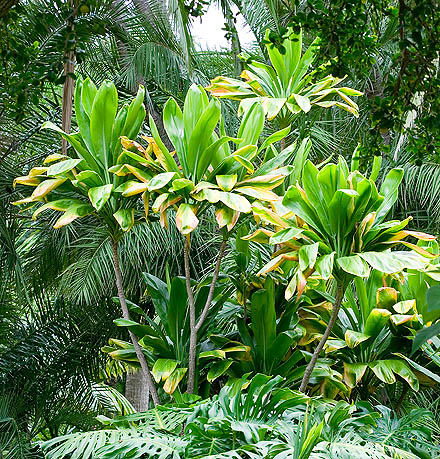Family : Asparagaceae

Text © Pietro Puccio

English translation by Mario Beltramini

Frequent in the tropical gardens and as indoor ornament © Giuseppe Mazza
The Cordyline fruticosa (L.) A. Chev. (1919) is native to Australia (Queensland), Papuasia (Bismarck Archipelago, Solomon Islands, Papua New Guinea) and to western Pacific (Caroline Islands, Marshall Islands, Wallis and Futuna Islands, Fiji, Marianas, Vanuatu).
The name of the genus comes from the Greek “kordyle” = cudgel, club, with reference to the shape of its rhizomatous roots; the species’ Latin name “fruticosa” = rich of buds, refers to its cespitose appearance.
Common names: “auti”, “karokaro”, “karo karo”, “ki”, “masawe”, “qai”, “qolo”, “qui”, “rauti”, “ti”, “vasili” (Polynesian dialects); “ti”, “ti tree”, “good luck tree”, “palm lily”, “Polynesian ti plant”, “tree of kings” (English); “Keulenlilie” (Greman); “arbol de la suerte”, “baston de San José”, “caña de indio”, “carey”, “chucho”, “croto”, “cuiza” (Spanish); “coqueiro-de-vênus”, “cordiline” (Portuguese).
Shrubby evergreen plant, not much ramified, tall up to about 4 m, with erect stems presenting on the apexes lance-shaped leaves, 40-60 cm long and 10-15 cm broad, of an intense glossy green colour; also varieties coloured differently do exist. Terminal panicle inflorescences long up to 60 cm, with white to reddish small flowers of about 12 mm of diameter, slightly perfumed. The fruits are purple red globose berries of about 8 mm of diameter, containing many black seeds. It easily reproduces by cutting, or by seed, if same is available.
Very spread plant in tropical and subtropical gardens in the coloured leaves variety; the one with wholly green leaves, slightly more resistant to low temperatures, can be marginally cultivated in the warm temperate climate areas.
Not particularly demanding about soil, it can be cultivated in full sun, of in slight shade, and can bear, when adult, to short periods of drought.
The coloured leaves varieties are rather sensitive to cold, as they do not resist to temperatures close to 0°C, they are therefore to be cultivated in pot, in the areas where such temperatures can be expected, and as such they are utilized for indoor decoration, in very luminous location, utilizing a well draining soil.
It is a plant which, in the past, has had a very huge importance for the Polynesian people, at the centre of religious and magic rituals and widely utilized as foodstuff and for obtaining sugar and an alcoholic beverage (from its roots rich in starch), whilst the leaves, rich in fibres, have been utilized for several usages, from thatching huts to clothing, sledding and cooking foods, and, last but not least, for decoration.
Synonyms: Convallaria fruticosa L. (1754); Asparagus terminalis L. (1762); Dracaena ferrea L. (1767); Dracaena terminalis L. (1767); Aletris chinensis Lam. (1783); Taetsia ferre a Medik. (1786); Cordyline terminalis (L.) Kunth (1844); Cordyline ferrea (L.) Endl. (1842), Cordyline jacquinii (L.) Kunth (1844); Calodracon jacquinii (Kunth) Planch. (1850); Cordyline terminalis var. ferrea (L.) Baker (1875); Terminalis fruticosa (L.) Kuntze (1891); Taetsia terminalis (L.) W. Wight ex Saff. (1905); Taetsia fruticosa (L.) Merr. (1917); Cordyline fruticosa var. ferrea (L.) R.R.Fernandez (1999).
→ To appreciate the biodiversity within the ASPARAGACEAE family please click here.
